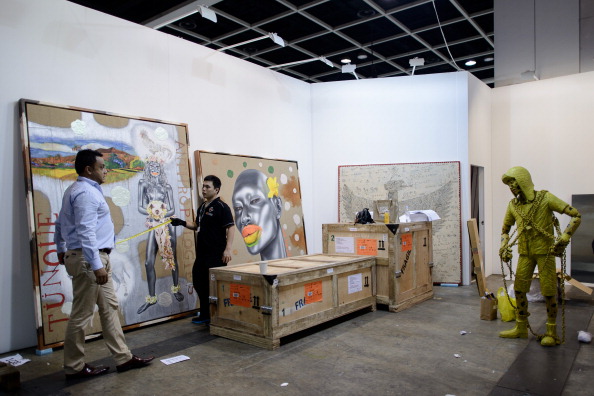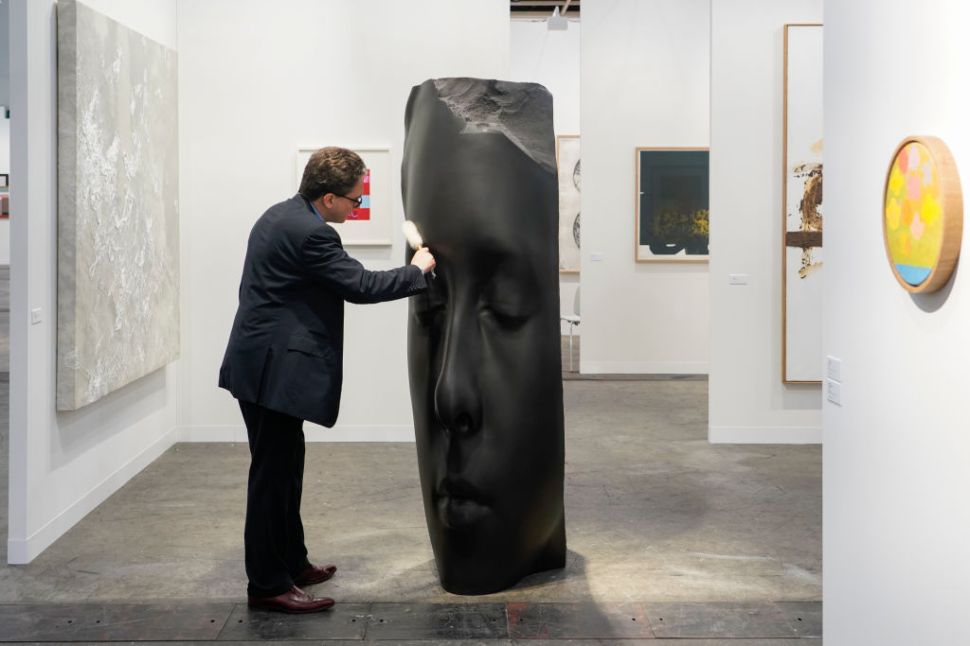It has been announced that TEFAF’s fall art and antiques show at the First Battery Armory in New York has been permanently canceled, but for years on one Friday night in late October, an odd jam of trucks crowded the traffic along Lexington Avenue, jockeying for position. On that night, the sidewalk leading up to the mouth of the 66th Street historic National Guard armory building entrance would be crowded with a rough line of workers standing around under a cloud of tension. Like soldiers stealing themselves for battle, veterans of the event would joke and chide each other about the work to come, smoke cigarettes and fuel up on coffee light and sweet.

Sundry boxes and crates of all sizes were wheeled along sidewalks and through the blitz of oncoming traffic. Inside, wrapped, braced and cushioned, were hundreds of millions of dollars worth of artwork. There was no security and no rules on this night. It was an armory show installation, and the race was on.
It wasn’t the largest, coolest or most elegant art fair in the world—or even in the city—but it was the definitive one, considered by dealers and buyers alike to be the bellwether of the season to come.
It was also logistically the most difficult show to put together—in part, because of the venue. It had the shortest time frame paired with the worst location. It was also corrupt, chaotic and unsafe, but in the end, always amazing. The massive gymnasium-like interior was transformed into something akin to a museum, with more than two hundred galleries showing some of the highest-value artworks in the world.
Over three nights and two days, gallery interiors were built to spec, and up to 15,000 paintings, sculptures and decorative works would be unboxed, hung, installed and assembled, each piece carefully placed with the lighting done just so. Usually, the booth setups would include a small office. Decorators and caterers would eventually arrive to arrange plants and furniture and assemble a cafe, ready to cool down the champagne for opening day. And when the 72-hour setup window closed, most of the workers would wander out and the wealthy and influential would wander in.
This was an armory show, not to be confused with the Armory Show, which has itself been many things over the years. The first armory show in 1913—officially the International Exhibition of Modern Art—was held at the smaller, older 69th Regiment Armory downtown, put on by members of the Association of American Painters and Sculptors (AAPS). Their plan was not only to expose their fellow Americans to modern European art but also to overturn the Payne–Aldrich Tariff Act, which restricted the import and export of artworks by levying heavy taxes.
The fair showed work by three hundred artists (about a hundred of whom were from Europe) and was inclusive of all the major art movements represented by the likes of Kandinsky, Gauguin, Géricault and Picasso, among others. Art collector and lawyer John Quinn opened the show by saying, “it was time the American people had an opportunity to see and judge for themselves concerning the work of the Europeans who are creating a new art.” And see it they did. New York audiences did not receive the show well yet came in masses. Critics had a field day lambasting the art fair, which was the first large exhibition of modern art in the U.S. One New York Times writer said Duchamp’s Nude Descending a Staircase looked “like an explosion in a shingle factory.” The work sold, though—and still does.

The making of an armory art fair
Companies like mine planned for the fall armory show all year round. It kicked off the fair season and would set the pace for us and other companies that traveled to multiple fairs across the U.S. and Europe. It’s where we had to work out the problems with whatever our clients had planned for that year.
It eventually became my job to organize and manage the armory shows for my firm. I had a core crew of about five skilled art handlers and would hire up to thirty “ants”—freelancers hired just to move boxes on the night of the install. I had a warehouse and started in earnest a few weeks before the show opened., overseeing the handling of as many as ten forty-foot containers, each holding a hundred crates of art. Every single one had to be unloaded, unpacked, categorized for delivery and stored accordingly. Some crates weighed several tons; others could be carried with one hand.
A good art handler has a unique mix of construction expertise, the patience and awareness to work with and around delicate and extremely expensive objects and a solid grounding in art history. It’s a set of skills that’s not easy to come by, and most of the art handlers in the country would be at the armory show during setup.
Back in the day, everyone had to be greased. At the armory, there was a door master: an old teamster who would receive the envelopes. No envelope, no luck—the job couldn’t be done without making the payoff, and the thicker the envelope, the easier life the job would be. There was only one power higher than the doorkeeper, and that was the Colonel of the armory itself. Aside from everything else we dealt with, the musty old place was still an official military garrison.
On the first night of the installation, construction would still be going on as the artwork arrived. Hundreds of union carpenters, electricians and painters erected prefab walls, pulling cable and painting all around with a clear disdain for the hundreds of art handlers and freelancers moving crates and unwrapping paintings in their midst. The forklifts and rolling scaffoldings took precedence over everything. Aisles would be cleared so one electrician could hang one light without ever having to come down from his perch on a cherry picker.
Hundreds of crates and boxes would roll in and out of the armory door. Rudimentary security procedures were in place, but security came down to the honor system. A single sticker that we ourselves would place proved the crates we took out were the ones we brought in—and were actually empty. Pieces did occasionally disappear due to theft, but some were put out of commission purely by accident.
Most of the workers on the floor of the armory had no business being there… no experience working with art, no respect for the work. Stories of destroyed artworks are widely traded. I recall the one about the Jean Arp being painted white along with its pedestal. The one about the run of Jim Dine prints that were cut down on a bandsaw to fit on a shelf built to the wrong dimensions. And I personally saw a forklift operator deliberately drop a cardboard bin full of framed paintings and drawings off the back of a truck on a dare.
In some cases, the service crews provided by the venue were simply not skilled enough for the galleries that would have whole interiors prefabricated and shipped over to be assembled overnight. This could be walls, floors, special lighting and anything else requiring a special, dedicated crew, sometimes imported by the dealer, to get the job done.
The dealers, assistants and hangers-on would be milling about on the floor on the first morning hoping to get started on the laborious process of actually installing the art. Some dealers were old pros, and it was a simple matter of “hang this next to that.” Others treated every show as if it was their first. Working with them meant hours of moving and shifting pieces around while bearing witness to meltdowns between business partners, or even husbands and wives, as they argued about how to organize their booths. The fights would last all day and often into the night, with pieces being swapped out until the last possible minute.
My core group would work from Friday night right up until the opening without ever leaving the building. When the guest doors opened and the critics, press, VIPs and socialites flowed in for their free drinks and canapes, a few of us might even still be there—sleep-deprived and starved, but still making last-minute changes. A painting lowered. A sculpture scooched a foot or so this way and then that.
Then four days later, the whole fair would be deconstructed. All the artwork was packed up, re-crated and put on trucks headed back to the warehouse, then loaded into containers for the next show, a week or two away in another city. Ironically, there was barely ever any work sold at any of those art fairs. It was all about the mingle, with a price tag of about $100,000 per gallery.
This insider’s view of the fairs may sound like the Wild West of the art world, but keep in mind most cultural institutions in the United States run this way behind closed doors. On the other side of the white walls, on the delivery trucks, in the warehouses that actually store and move the pieces, you’re generally working with people who have no specific education or training in dealing with artwork. The actual workers who make the art fairs run are often as far from the viewing floor as a dishwasher at a posh restaurant is from ever getting a table.
